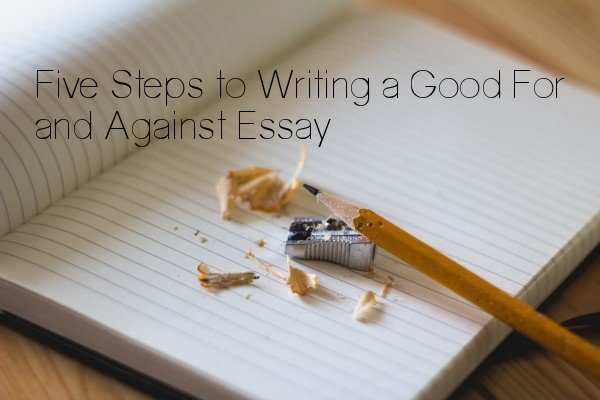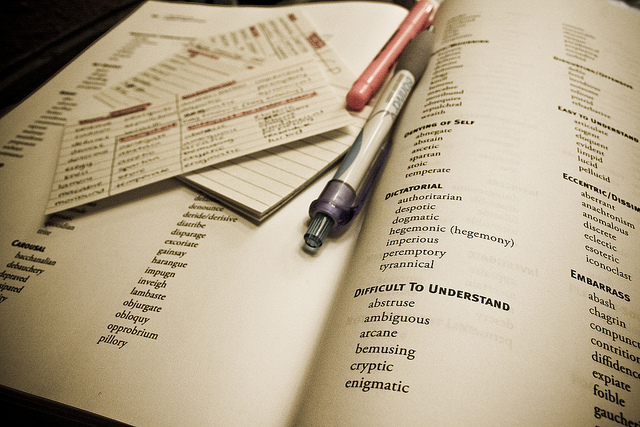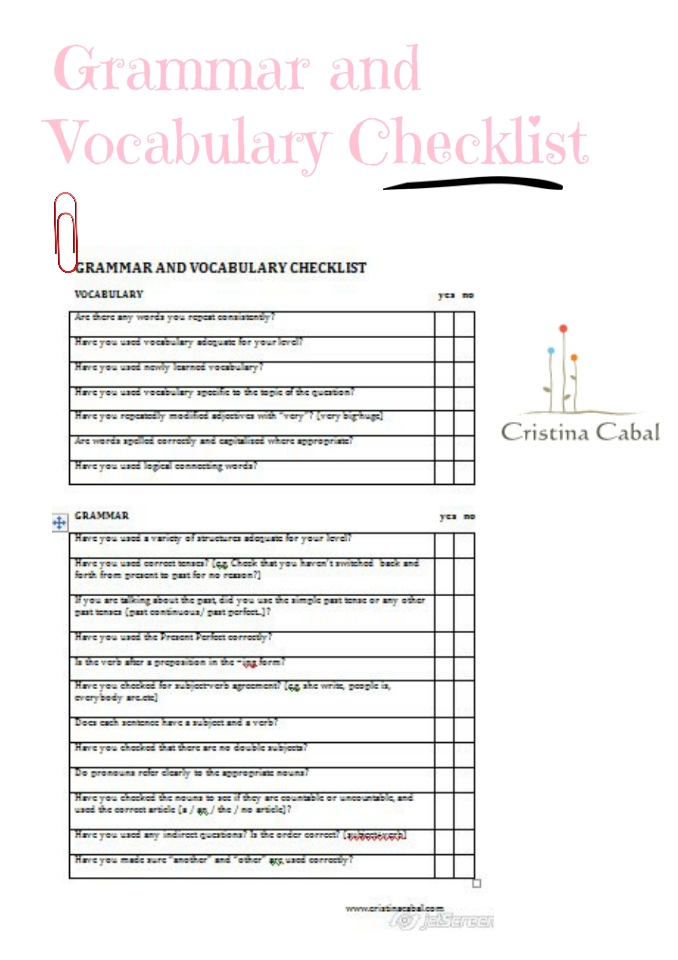An essay is a formal piece of writing which describes, analyses or discusses a particular issue.
The most common types are:
- Opinion essays. They present the writer’s personal opinion of the topic, supported with examples and reasons.
- For and against essays. They present both sides of an issue in a balanced way. In the concluding paragraph you can say why you find one side more convincing than the other.
In this post, I’ll guide you step by step to help you write a good for and against essay.
- Step 1. Tips and Guidelines +sample essay (pdf)
- Step 2. Presentation + sample essay (reinforcing)
- Step 3. Using connectors of contrast
- Step 4. Using connectors of purpose
- Step 5. Write: 53 topics to write about. (pdf)

Step 1. Tips and guidelines+sample essay
1. The first stage in writing is producing ideas. It’s important to dedicate two or three minutes to carefully planning what you are going to say. Make a list of the points for and against. Remember that the key to writing a good balanced essay is to include as many arguments you disagree with as those you agree with. They should be noted impartially although in your conclusion you can say why you find one side more convincing than the other.
2. Producing and organising ideas is one thing. Shaping ideas and the organisation of your writing is another. But often the most difficult part is starting a first draft.
Once you have your first draft pay attention to how you have organised the information into paragraphs and grouped ideas.
Once this is done you can focus on expression. This means looking at sentence structure, tense usage and vocabulary. It’s important to write clearly and economically. This can mean either rephrasing ideas in two sentences instead of one, or rewriting two longer sentences as one shorter sentence. So, go over your first draft, looking for ways of improving sentence structure, tense usage and vocabulary.
3. Organise your essay into three parts:
- Introduction- Paragraph 1- Introduce the topic. The opening should engage the reader’s interest and give a hint of what is to follow.
- Main Body- Normally you have two paragraphs. In Paragraph 2, you state your arguments for and in Paragraph 3, your arguments against.
- Conclusion– In paragraph 4 you refer back to the topic and summarize. Here you can say why you find one side more convincing than the other.
4. It’s important that you begin each paragraph with a main idea and then develop this idea. For a new idea, begin a new paragraph.
5. This is academic writing, so don’t use informal style ( no contractions, colloquial words, or emotional language).
6. Remember to use a variety of structures and vocabulary adequate to your level.
Step 2. Presentation + sample essay (reinforcing ).
Step 3. Using connectors of contrast.
Using connectors is important to express different relationships between ideas. Here, you’ll learn how to use connectors of contrast.
Read the flyer below to learn how to use: despite/in spite of, nevertheless, however, on the other hand, although, even though, though, yet, still, but and while/whereas.
At the end of the flyer there are some interactive exercises to test your knowledge.
Step 3. Using connectors of purpose.
Now we learn how to express purpose with the following words: to, in order to, so as to, for, so that and in case.
Test your knowledge
Step 5. Write: 53 topics to write about. Pdf here
Are you ready to write now? Here’s a compilation of 53 for and against topics to write about from different sites and course books. Take your pick, follow all the tips and guidelines and good luck!
EDUCATION
- Should schools start later in the morning?
- Benefits of teaching children second languages early on.
- The pros and cons of single gender classrooms.
- Is sex education the job of parents or of the school?
- The pros and cons of reduction of physical education hours in our current school system.
- The pros and cons of security cameras in schools.
- Pros and cons of a 4-day school week.
- Should parents pay students for good grades?
- The pros and cons of bilingual or dual language education.
- The pros and cons of wearing a uniform.
- The pros and cons of banning junk food in schools.
- Should sexual education be taught in high schools?
- The education a child receives at home from having parents who are positive role models is more important than the academic education a child receives at school. To what extent do you agree or disagree?
HEALTHY ISSUES
- Plastic surgery- vanity or need?
- Is vegetarianism a healthy diet?
- One of the largest parts of government expenditure is health. Some people argue that this money would be better spent on health education on the principle that prevention is better than cure. To what extent do you agree or disagree?
MORAL ISSUES
- Should parents be allowed to choose their child’s gender?
- Pros and cons of having exotic animals as home pets?
- Should advertising for plastic surgery be illegal?
- Should priests be celibate?
- What does everyone think about zoo animals? Is it a good or a bad thing?
- Does legal prostitution reduce crime?
- To what extent is the use of animals in scientific research acceptable? Discuss the pros and cons.
- Some people argue that the amount of violence shown in films and on television has led to an increase in violent crimes in society. Do you agree with this argument? Should the government control what is shown on television and in the cinema?
- Should rich countries forgive all debts for poor countries?
TECHNOLOGY
- The pros and cons of children under the age of 10 playing video games.
- The pros and cons of film, television, and music piracy.
- Should kids under the age of 13 have a phone?
- Advantages and disadvantages of digital spying on kids and teens.
- The pros and cons of owning an electric car.
- Have we become too dependent on technology? Discuss the pros and cons.
- Should students be allowed to have cell phones in elementary and high schools?
- Should we ban the sale of violent video games?
- Some people say that the Internet is making the world smaller by bringing people together. To what extent do you agree that the Internet is making it easier for people to communicate with one another?
SPORTS
- Should pro wrestling be considered a sport?
- Should sport hunting be banned?
- Many people want their country to hold the Olympics. Others believe that international sporting events bring more problems than benefits. Discuss both views and state your opinion.
FREE TIME
- In the future, we will have more and more leisure time as machines replace many of the tasks we do at home and work. Discuss the benefits this will bring and also the problem it will cause.
- It is said that travel broadens the mind. What can we learn by travelling to other countries? Should we first explore our own countries? Discuss.
- In many countries tourism is a major part of the economy, but it also causes environmental damage and ruins the places it exploits. It is argued that tourists should pay an additional tax to compensate for this damage. Do you agree?
- Should museums and art galleries be free of charge for the general public, or should a charge, even a voluntary charge, be levied for admittance? Discuss this issue, and give your opinion.
EMPLOYMENT
- Unemployment is one of the most serious problems facing developed nations today. What are the advantages and/or disadvantages of reducing the working week to thirty five hours?
- Most high level jobs are done by men. Should the government encourage a certain percentage of these jobs to be reserved for women?
- Should retirement be compulsory at 65 years of age?
GLOBALISATION:
- Differences between countries become less evident each year. Nowadays, all over the world people share the same fashions, advertising, brands, eating habits and TV channels. What are the advantages and disadvantages of this?
- Television has had a significant influence on the culture of many societies. To what extent would you say that television has positively or negatively affected the cultural development of your society?
HOUSING
- Some people like living in a house, while others prefer an apartment. Are there more advantages than disadvantages to living in a house rather than in an apartment?
FAMILY AND RELATIONSHIPS
- The pros and cons of gay marriage.
- Some parents choose not to have a television at home because of the influence on their children. Is this a good or a bad thing?
- Some people believe in the traditional idea that the woman’s place is in the home, while others say that idea is outdated and that women should play an increasingly important role in the workplace of the future. What is your opinion?
- People are now living longer than ever before and many old people are unable to look after themselves. Some people believe that it is the responsibility of families to look after the elderly, while others say governments should provide retirement homes for them where they can be looked after properly. Discuss.
- Are women better parents than men?
- If children behave badly, should their parents accept responsibility and also be punished?
Have you visited my writing section yet?




